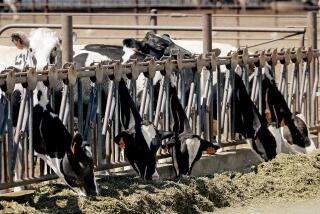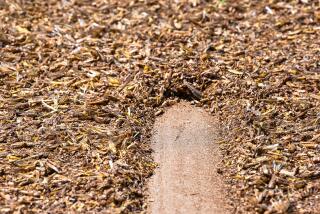Op-Ed: Who’s to blame for the avocado shortage? Californians
The great avocado shortage of 2016 has been blamed on labor strikes in Mexico, California’s protracted drought, an invidious beetle that destroys avocado groves, and a changing climate that is less hospitable to the crop. There’s another factor: Californians have been proselytizing the fruit for years, driving up demand to impossibly high levels.
In fairness, the first proselytizer was a Spanish historian. It was in the 16th century that Gonzalo Fernandez de Oviedo, traveling with a party of conquistadors, happened upon a fruit tree unknown to Europeans.
Its “pears” weighed a pound or so, and their flesh, surrounding a seed like a peeled chestnut, “is a paste similar to butter and of very good eating and of good taste, such that those who have these fruits guard them and esteem them highly,” he explained. “They are gathered before they are ripe and stored, and when treated thus they ripen perfectly for eating but after they have reached this stage they spoil quickly if allowed to stand.”
In the 1990s, the average American ate only about 1.5 pounds of avocado a year... By 2012, that 1.5-pound average had skyrocketed to 5 pounds.
In search of gold, the Spaniards had found an Eden of avocado trees, “for the chief gardener is God, and Indians apply no work whatever to them.” And they couldn’t shut up about them. By the 1700s, European sailors “called avocados ‘midshipman’s butter’ because they used them as a spread on hardtack,” John S. Shepherd and Gary S. Bender wrote in their “History of the Avocado Industry in California.” They estimate that the Golden State’s first avocado tree was planted around 1850, and go on to detail the fruit’s proliferation throughout Southern California.
Among others, they credit a Los Angeles Athletic Club chef who saved the seeds from imported avocados so that local groves could be planted; John T. Whedon, owner of a Yorba Linda orchard where an early strain of commercially successful avocados were grown; and the birth of the California Ahuacate Assn. and the California Avocado Society.
Until relatively recently, non-Californians remained mostly uninterested in avocados; many Americans had never even tasted one, and many of the rest had tried one at the wrong time, before it was ripe.
“Growing up, I thought that they were disgusting,” an East Coast acquaintance in her early 30s recalled. “They were either rock hard or mealy, and I didn’t understand why anyone would want them, especially because they were so expensive.”
In the 1990s, the average American ate only about 1.5 pounds of avocado a year.
Starting at the end of the last century, though, industry groups began aggressively extolling and exporting the fruit. By 2012, that 1.5-pound average had skyrocketed to 5 pounds.
One campaign focused on Super Bowl Sunday.
“Super Bowl week trails only Cinco de Mayo as the most important week of the year for California avocados,” according to a news release sent out by California Avocado Commission, a trade organization.
Last year, 80 million pounds of avocados were consumed on game day.
Of course, individual Californians bear some responsibility too. My East Coast acquaintance now loves avocados; she was converted by my guacamole recipe.
Californians’ missionary work has been so successful that menus across the United States now describe an omelet or sandwich or sushi roll with avocado added as “California style.” The fruit spread along with Mexican cuisine so that today, adding guacamole to lunch or dinner is as easy as finding a Chipotle location.
Yet last week, when I ordered chips and guacamole to start my meal at Clutch, Oscar Hermosillo’s Cali-Mex roadhouse in Venice, I was told by the waitress, “Oh, we don’t have that today, because of the shortage.”
“How dumb of us,” I thought.
We knew that indigenous people not only esteemed the avocado, but guarded their stores. We knew that this delicate crop couldn’t grow just anywhere, and that Californians wield rare trendsetting power. Yet we did the foodie equivalent of bragging to everyone we know about an awesome surf break. Now the people of Cincinnati alone consume more than 16 million avocados per year.
And we’re left without enough avocados for ourselves.
The time has come to recover this precious staple of local cuisine. I have a plan. Californians seem to have turned vast swaths of the country against gluten, and I suggest a conspiracy to do the same with the avocado.
We need to cease all avocado evangelizing, recruit Gwyneth Paltrow for a scathing Goop takedown of guacamole, and start posting photos of day-old avocado slices, their flesh oxidized to an unappealing brown, on Instagram. Caption: “Yuck. Who’d want an avocado. That’s something we ate back when we didn’t know better, like when Californians still liked O.J. Simpson and Mel Gibson.” If all goes per usual, the rest of America will absorb our cultural propaganda, even as they purport to resent us and ignore daily life here.
We’ll go back to adding avocado for $1 and live happily ever after.
Conor Friedersdorf is a contributing writer to Opinion, a staff writer at the Atlantic and founding editor of the Best of Journalism, a newsletter that curates exceptional nonfiction.
Follow the Opinion section on Twitter @latimesopinion and Facebook
More to Read
A cure for the common opinion
Get thought-provoking perspectives with our weekly newsletter.
You may occasionally receive promotional content from the Los Angeles Times.










